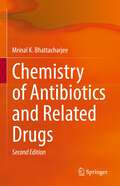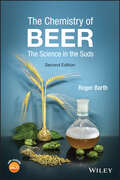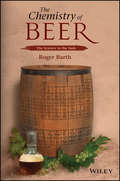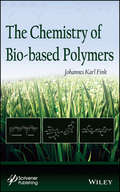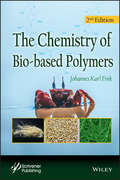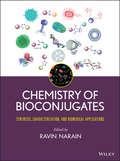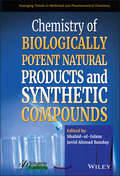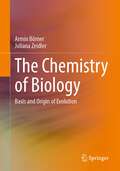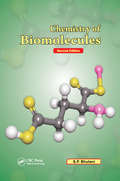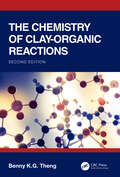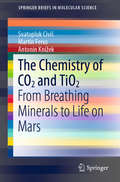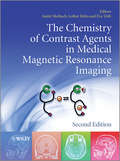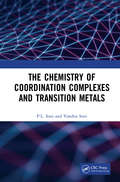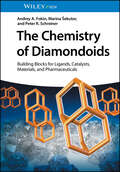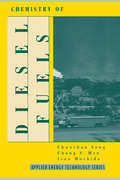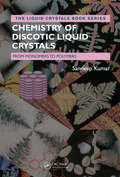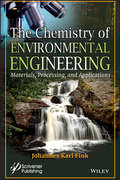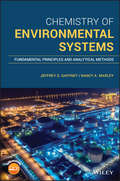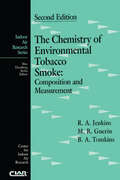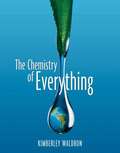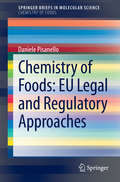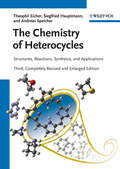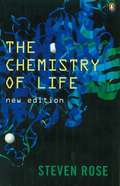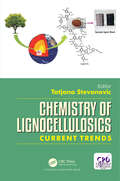- Table View
- List View
Chemistry of Antibiotics and Related Drugs
by Mrinal K. BhattacharjeeThis textbook builds on the success of the earlier edition, offering alternative strategies for discovering new antibiotics. It discusses how the various types of antibiotics and related drugs work to cure infections. Then it delves into the very serious matter of how bacteria are becoming resistant to these antibiotics. It also covers the global action plan on antimicrobial resistance from the World Health Organization and discusses several Antibiotic Stewardship Programs adopted by agencies at local levels. Appropriate for a one-semester course at either the graduate or advanced undergraduate level, the book is self-contained and written in accessible language. It includes all necessary background biochemistry material and a discussion of the latest developments in the field of antibiotics. Original research works are frequently cited and experimental procedures and interpretation of results are emphasized.
The Chemistry of Beer: The Science in the Suds
by Roger BarthThe Chemistry of BEER An Engaging Introduction to Chemistry with a Popular Theme From the earliest civilizations to our own day, brewing beer has driven science and technology. In ancient times, brewing was the most advanced biotechnical process. In the modern world, the study of alcoholic fermentation was the springboard for the new science of biochemistry. The Chemistry of Beer: The Science in the Suds, 2nd Edition explains the scientific basis of each brewing step as we understand it today. Readers of this second edition will find: Updates and revisions include a new chapter on beer-related products such as hard seltzer, flavored malt beverages, and non-alcoholic beer Streamlined language and structure to help clarify the chemistry Over 200 illustrations, now in full color throughout Complete glossary and index Question sets at the end of each chapter to check for understanding Online solutions manual on a companion website for professors The Chemistry of Beer: The Science in the Suds, 2nd Edition is designed to engage students in an introductory chemistry course. Optional material extends the level to make it a useful supplement for a brewing science course. The material and style of presentation will interest brewing professionals, others in the beverage industry, advanced homebrewers, and beer enthusiasts.
The Chemistry of Beer
by Roger BarthDiscover the science of beer and beer makingEver wondered just how grain and water are transformed into an effervescent, alcoholic beverage? From prehistory to our own time, beer has evoked awe and fascination; it seems to have a life of its own. Whether you're a home brewer, a professional brewer, or just someone who enjoys a beer, The Chemistry of Beer will take you on a fascinating journey, explaining the underlying science and chemistry at every stage of the beer making process. All the science is explained in clear, non-technical language, so you don't need to be a PhD scientist to read this book and develop a greater appreciation for the world's most popular alcoholic drink.The Chemistry of Beer begins with an introduction to the history of beer and beer making. Author Roger Barth, an accomplished home brewer and chemistry professor, then discusses beer ingredients and the brewing process. Next, he explores some core concepts underlying beer making. You'll learn chemistry basics such as atoms, chemical bonding, and chemical reactions. Then you'll explore organic chemistry as well as the chemistry of water and carbohydrates. Armed with a background in chemistry principles, you'll learn about the chemistry of brewing, flavor, and individual beer styles. The book offers several features to help you grasp all the key concepts, including:Hundreds of original photographs and line drawingsChemical structures of key beer compoundsGlossary with nearly 1,000 entriesReference tablesQuestions at the end of each chapterThe final chapter discusses brewing at home, including safety issues and some basic recipes you can use to brew your own beer.There's more to The Chemistry of Beer than beer. It's also a fun way to learn about the science behind our technology and environment. This book brings life to chemistry and chemistry to life.
The Chemistry of Benzotriazole Derivatives
by Jean-Christophe M. MonbaliuThe series Topics in Heterocyclic Chemistry presents critical reviews on present and future trends in the research of heterocyclic compounds. Overall the scope is to cover topics dealing with all areas within heterocyclic chemistry, both experimental and theoretical, of interest to the general heterocyclic chemistry community. The series consists of topic related volumes edited by renowned editors with contributions of experts in the field. All chapters from Topics in Heterocyclic Chemistry are published Online First with an individual DOI. In references, Topics in Heterocyclic Chemistry is abbreviated as Top Heterocycl Chem and cited as a journal.
The Chemistry of Bio-based Polymers
by Johannes Karl FinkAn exhaustive and timely overview of renewable polymers from a respected chemist and successful author The recent explosion of interdisciplinary research has fragmented the knowledge base surrounding renewable polymers. The Chemistry of Bio-based Polymers brings together, in one volume, the research and work of Professor Johannes Fink, focusing on biopolymers that can be synthesized from renewable polymers. After introducing general aspects of the field, the book’s subsequent chapters examine the chemistry of biodegradable polymeric types sorted by their chemical compounds, including the synthesis of low molecular compounds. Various categories of biopolymers are detailed including vinyl-based polymers, acid and lactone polymers, ester and amide polymers, carbohydrate-related polymers and others. Procedures for the preparation of biopolymers and biodegradable nanocomposites are arranged by chemical methods and in vitro biological methods, with discussion of the issue of “plastics from bacteria.” The factors influencing the degradation and biodegradation of polymers used in food packaging, exposed to various environments, are detailed at length. The book covers the medical applications of bio-based polymers, concentrating on controlled drug delivery, temporary prostheses, and scaffolds for tissue engineering. Professor Fink also addresses renewable resources for fabricating biofuels and argues for localized biorefineries, as biomass feedstocks are more efficiently handled locally. Audience The Chemistry of Bio-based Polymers will be read by chemists, polymer and materials scientists, chemical, bio-based, and biomedical engineers, agricultural and environmental faculty and all those who work in the bioeconomy area. This book will be critical for engineers in a number of industries including food packaging, medical devices, personal care, fuels, auto, and construction.
The Chemistry of Bio-based Polymers
by Johannes Karl FinkThe recent explosion of interdisciplinary research has fragmented the knowledge base surrounding renewable polymers. The Chemistry of Bio-based Polymers 2nd edition brings together, in one volume, the research and work of Professor Johannes Fink, focusing on biopolymers that can be synthesized from renewable polymers. After introducing general aspects of the field, the book’s subsequent chapters examine the chemistry of biodegradable polymeric types sorted by their chemical compounds, including the synthesis of low molecular compounds. Various categories of biopolymers are detailed including vinyl-based polymers, acid and lactone polymers, ester and amide polymers, carbohydrate-related polymers and others. Procedures for the preparation of biopolymers and biodegradable nanocomposites are arranged by chemical methods and in vitro biological methods, with discussion of the issue of “plastics from bacteria.” The factors influencing the degradation and biodegradation of polymers used in food packaging, exposed to various environments, are detailed at length. The book covers the medical applications of bio-based polymers, concentrating on controlled drug delivery, temporary prostheses, and scaffolds for tissue engineering. Professor Fink also addresses renewable resources for fabricating biofuels and argues for localized biorefineries, as biomass feedstocks are more efficiently handled locally.
Chemistry of Bioconjugates
by Ravin NarainExplores bioconjugate properties and applications of polymers, dendrimers, lipids, nanoparticles, and nanotubesBioconjugation has enabled breakthroughs across many areas of industry and biomedicine. With its emphasis on synthesis, properties and applications, this book enables readers to understand the connection between chemistry and the biological application of bioconjugated materials. Its detailed descriptions of methods make it possible for researchers to fabricate and take full advantage of bioconjugates for a broad range of applications. Moreover, the book sets the foundation for the development of new applications, including assays, imaging, biosensors, drug delivery, and diagnostics.Chemistry of Bioconjugates features contributions from an international team of leading experts and pioneers in the field. These contributions reflect the authors' firsthand laboratory experience as well as a thorough review of the current literature. The book's six sections examine:General methods of bioconjugationPolymer bioconjugatesOrganic nanoparticle-based bioconjugatesInorganic nanomaterial bioconjugates, including metals and metal oxidesCell-based, hydrogel/microgel, and glyco-bioconjugatesCharacterization, physico-(bio)chemical properties, and applications of bioconjugatesThis comprehensive exploration of bioconjugates includes discussions of polymers, dendrimers, lipids, nanoparticles, and nanotubes. References at the end of each chapter serve as a gateway to the most important original research findings and reviews in the field.By drawing together and analyzing all the latest chemical methods and research findings on the physico-chemical and biochemical properties of bioconjugates, Chemistry of Bioconjugates sheds new light on the significance and potential of bioconjugation. The book is recommended for organic and polymer chemists, biochemists, biomaterial scientists, carbohydrate chemists, biophysicists, bioengineers, and drug and gene delivery scientists.
Chemistry of Biologically Potent Natural Products and Synthetic Compounds (Emerging Trends in Medicinal and Pharmaceutical Chemistry)
by Shahid-Ul-Islam Javid Ahmad BandayIn view of their promising biological and pharmaceutical activities, natural product inspired and heterocyclic compounds have recently gained a reputation in the field of medicinal chemistry. Over the past decades, intensive research efforts have been ongoing to understand the synthesis, biochemistry and engineering involved in their preparation and action mechanisms. Several novel natural product derivatives, heterocyclic and other synthetic compounds, have been reported to have shown interesting biological activities including anticancer, antimicrobial, anti-inflammatory, anti-glycemic, anti-allergy and antiviral etc. Chemistry of Biologically Potent Natural Products and Synthetic Compounds provides up-to-date information on new developments and most recent medicinal applications of the natural products and derivatives, as well as the chemistry and synthesis of heterocyclic and other related compounds.
The Chemistry of Biology: Basis and Origin of Evolution
by Armin Börner Juliana ZeidlerLiving organisms are distinguished by their chemical basis. Thus, knowledge of the properties of the elements and the interactions of the resulting compounds is a prerequisite for understanding biology.Chemistry answers the questions of why, among the more than 100 elements of the periodic table (PSE), carbon and not silicon is the dominant element in biology and why precious metals, such as gold and silver, do not play a role. The PSE provides information about why phosphoric acid and not sulfuric acid acts as a bridge in polynucleic acids and why DNA had to evolve from RNA. At the same time, only chemistry makes clear why D-glucose is so central in building biopolymers such as cellulose and glycogen, and why the citrate cycle is logically self-contained and without alternative. Biochemistry is also a synthesis chemistry that differs from "man-made" synthesis chemistry "only" in terms of the framework conditions. Individuals are selected from the multitude of elements of the PSE and the almost infinite number of chemical compounds. The selection is based on the environmental conditions on Earth, such as moderate temperatures, preferably atmospheric pressure, solvent water and as primary reaction partner oxygen.The hypothesis is developed that the guiding principle of modern biology, the theory of evolution, has its roots in the underlying chemistry. This turns Darwinism from its biological head to its chemical feet. For example, the effect of phenols as radical scavengers is a priori chemical, before biological phenomena could evolve from it as differences in distinction in colored flowering plants. The book develops a completely new, chemistry-centered view of "animate nature" and challenges a changed, biologically oriented didactics of chemistry in schools and universities.
Chemistry of Biomolecules, Second Edition
by S. BhutaniAbout the Book: Biomolecules are those molecules that are involved in the maintenance and metabolic processes of all living organisms. This fully revised second edition offers extensive coverage of important biomolecules from organic chemistry point of view. The author discusses carbohydrates, amino acids, peptides, proteins, enzymes, pyrimidines, purines, nucleic acids, lipids, terpenoids and alkaloids. The various topics are described in simple, lucid language and the mechanisms of the reactions are explained wherever required. Ideal for upper level undergraduates, graduates and researchers. Features: The author discusses the basic organic chemistry of the main families of biomolecules. Gives comprehensive information on biogenic substances. Includes a new chapter on alkaloids. It is a one-stop work with complete information about important biomolecules. This second edition will now appeal to upper level undergraduates as well as graduates.
The Chemistry of Clay-Organic Reactions
by Benny K.G ThengThe second edition of The Chemistry of Clay-Organic Reactions book provides a comprehensive and fully updated summary of the literature on the interactions of clay minerals with organic molecules, including reaction mechanisms and bonding modes together with their practical and industrial applications. The reader will gain an insight into the formation and properties of complexes between clay minerals and a variety of organic compounds and the use of such complexes as sorbents and carriers of organic pollutants, pesticides, dyes, and pharmaceuticals.KEY FEATURES An authoritative resource providing a detailed synthesis of published data on clay-organic complexes and reactions. Authored by a globally recognized expert in the field. Describes developments in the interactions of organic compounds with fibrous and short-range order clay minerals. This book is written for environmental and industrial chemists, organic geochemists, and soil scientists, and it will appeal to academics, researchers, industry professionals, and graduate students.
The Chemistry of CO2 and TiO2: From Breathing Minerals to Life on Mars (SpringerBriefs in Molecular Science)
by Svatopluk Civiš Martin Ferus Antonín KnížekThis book provides a comprehensive overview of the chemistry of CO2 in relation to surface interactions and photocatalytic transformation by UV radiation. The first part deals with the modelling of an anatase surface, its interaction with CO2, and the spontaneous exchange of oxygen atoms between the gas and solid phases. The book then naturally transitions to the photocatalytic reduction of CO2, achieved by adding UV radiation and traces of water to the experimental system, to produce methane and CO. This photocatalytic reduction is explained in detail and the implications for planetary chemistry (specifically concerning Mars), as well as Earth’s atmospheric chemistry and global warming, are discussed.
The Chemistry of Contrast Agents in Medical Magnetic Resonance Imaging
by Lothar Helm Éva Tóth Andre S. MerbachMagnetic Resonance Imaging (MRI) is one of the most important tools in clinical diagnostics and biomedical research. The number of MRI scanners operating around the world is estimated to be approximately 20,000, and the development of contrast agents, currently used in about a third of the 50 million clinical MRI examinations performed every year, has largely contributed to this significant achievement.This completely revised and extended second edition: Includes new chapters on targeted, responsive, PARACEST and nanoparticle MRI contrast agents.Covers the basic chemistries, MR physics and the most important techniques used by chemists in the characterization of MRI agents from every angle from synthesis to safety considerations.Is written for all of those involved in the development and application of contrast agents in MRI.Presented in colour, it provides readers with true representation and easy interpretation of the images. A word from the Authors:Twelve years after the first edition published, we are convinced that the chemistry of MRI agents has a bright future. By assembling all important information on the design principles and functioning of magnetic resonance imaging probes, this book intends to be a useful tool for both experts and newcomers in the field. We hope that it helps inspire further work in order to create more efficient and specific imaging probes that will allow materializing the dream of seeing even deeper and better inside the living organisms.Reviews of the First Edition:"...attempts, for the first time, to review the whole spectrum of involved chemical disciplines in this technique..."--Journal of the American Chemical Society"...well balanced in its scope and attention to detail...a valuable addition to the library of MR scientists..."--NMR in Biomedicine
The Chemistry of Coordination Complexes and Transition Metals
by P.L. Soni Vandna SoniThis book covers all important nomenclature, theories of bonding and stereochemistry of coordination complexes. The authors have made an effort to inscribe the ideas knowledge, clearly and in an interesting way to benefit the readers. The complexities of Molecular Orbital theory have been explained in a very simple and easy manner. It also deals with transition and inner transition metals. Conceptually, all transition and inner transition elements form complexes which have definite geometry and show interesting properties. General and specific methods of preparation, physical and chemical properties of each element has been discussed at length. Group wise study of elements in d-block series have been explained. Important compounds, complexes and organometallic compounds of metals in different oxidation states have been given explicitly. Note: T&F does not sell or distribute the Hardback in India, Pakistan, Nepal, Bhutan, Bangladesh and Sri Lanka.
The Chemistry of Diamondoids: Building Blocks for Ligands, Catalysts, Pharmaceuticals, and Materials
by Andrey A. Fokin Marina Sekutor Peter R. SchreinerThe Chemistry of Diamondoids Comprehensive resource on an important and fascinating compound class, covering synthesis, properties, functionalization, and applications in organic synthesis, materials science, and more The Chemistry of Diamondoids gives a state-of-the-art overview of all aspects of diamondoid chemistry, covering nomenclature, natural occurrence, chemical and physical properties, along with synthesis and functionalization of diamondoids as well as their applications as molecular building blocks in organic synthesis, polymer and materials science, nanotechnology, and medicinal chemistry. The book concludes with a perspective towards future developments in the field, thereby drawing attention to areas open for discovery. Written by experts in the field, The Chemistry of Diamondoids includes information on: Naturally occurring diamondoids, their formation, and the role they play in the petroleum industry and in geosciences, plus man-made approaches to prepare them on large scale Growing diamond from diamondoids via seeding, preparation and properties of diamondoid oligomers and doped diamondoids C–H-bond functionalization, a precondition for their use in many applications, and fine-tuning of diamondoid properties by precise cage substitution reactions With its all-encompassing approach, The Chemistry of Diamondoids is a valuable guide for newcomers and researchers in organic chemistry and materials science interested in modern synthetic methods and organic functional materials.
Chemistry of Diesel Fuels
by Chunsham SongThis edited work covers diesel fuel chemistry in a systematic fashion from initial fuel production to the tail pipe exhaust. The chapters are written by leading experts in the research areas of analytical characterization of diesel fuel, fuel production and refining, catalysis in fuel processing, pollution minimization and control, and diesel fuel additives.
Chemistry of Discotic Liquid Crystals: From Monomers to Polymers (Liquid Crystals Book Series)
by Sandeep KumarThe self-contained properties of discotic liquid crystals (DLCs) render them powerful functional materials for many semiconducting device applications and models for energy and charge migration in self-organized dynamic functional soft materials. The past three decades have seen tremendous interest in this area, fueled primarily by the possibility
The Chemistry of Environmental Engineering
by Johannes Karl FinkThe focus of this book is the chemistry of environmental engineering and its applications, with a special emphasis on the use of polymers in this field. It explores the creation and use of polymers with special properties such as viscoelasticity and interpenetrating networks; examples of which include the creation of polymer-modified asphalt as well as polymers with bacterial adhesion properties. The text contains the issues of polymerization methods, recycling methods, wastewater treatment, types of contaminants, such as microplastics, organic dyes, and pharmaceutical residues. After a detailed overview of polymers in Chapter 1, their special properties are discussed in the following chapter. Among the topics is the importance of polymers to water purification procedures, since their use in the formation of reverse osmosis membranes do not show biofouling. Chapter 3 details special processing methods, such as atom transfer radical polymerization, enzymatic polymerization, plasma treatment, and several other methods, can be used to meet the urgent demands of industrial applications. Chapter 4 addresses the important environmental issue of recycling methods as they relate to several types of materials such as PET bottles, tire rubbers, asphalt compositions, and other engineering resins. And wastewater treatment is detailed in Chapter 5, in which the types of contaminants, such as microplastics, organic dyes and pharmaceutical residues, are described and special methods for their proper removal are detailed along with types of adsorbents, including biosorbents. Still another important issue for environmental engineering chemistry is pesticides. Chapter 6 is a thorough description of the development and fabrication of special sensors for the detection of certain pesticides. A detailed presentation of the electrical uses of polymer-based composites is given in Chapter 7, which include photovoltaic materials, solar cells, energy storage and dielectric applications, light-emitting polymers, and fast-charging batteries. And recent issues relating to food engineering, such as food ingredient tracing, protein engineering, biosensors and electronic tongues, are presented in Chapter 8. Finally, polymers used for medical applications are described in Chapter 9. These applications include drug delivery, tissue engineering, porous coatings and also the special methods used to fabricate such materials.
Chemistry of Environmental Systems: Fundamental Principles and Analytical Methods
by Jeffrey S. Gaffney Nancy A. MarleyA modern guide to environmental chemistry Chemistry of Environmental Systems: Fundamental Principles and Analytical Methods offers a comprehensive and authoritative review of modern environmental chemistry, discussing the chemistry and interconnections between the atmosphere, hydrosphere, geosphere and biosphere. Written by internationally recognized experts, the textbook explores the chemistries of the natural environmental systems and demonstrates how these chemical processes change when anthropogenic emissions are introduced into the whole earth system. This important text: Combines the key areas of environmental chemistry needed to understand the sources, fates, and impacts of contaminants in the environment Describes a range of environmental analytical methodologies Explores the basic environmental effects of energy sources, including nuclear energy Encourages a proactive approach to environmental chemistry, with a focus on preventing future environmental problems Includes study questions at the end of each chapter Written for students of environmental chemistry, environmental science, environmental engineering, geoscience, earth and atmospheric sciences, Chemistry of Environmental Systems: Fundamental Principles and Analytical Methods covers the key aspects and mechanisms of currently identified environmental issues, which can be used to address both current and future environmental problems.
The Chemistry of Environmental Tobacco Smoke: Composition and Measurement, Second Edition (Indoor Air Research)
by Roger A. Jenkins Bruce Tomkins Michael R. GuerinConsidered the definitive resource in its field, The Chemistry of Environmental Tobacco Smoke: Composition and Measurement compiles observations on the properties of Environmental Tobacco Smoke (ETS) and on the concentrations of its constituents in indoor air. It focuses on common natural indoor environments and environments associated with chronic exposure. The authors -- all renowned experts -- stress both measurement methods and the competing sources of indoor air contaminants commonly attributed to ETS. For the second edition, each chapter has been updated to reflect new studies and up-to-date information.
The Chemistry of Everything
by Kimberley WaldronThe Chemistry of Everything addresses the "need-to-know" basics of chemistry required to grasp everyday science issues. Through innovative themes and creative applications, it provides an engaging introduction to chemistry for nonscience majors. Mixes basic chemical principles from physical, inorganic, organic, analytical, and biological specializations to support thematic coverage of topics such as diamonds, groceries, and drugs. Extends readers' vocabulary and knowledge of the scientific issues encountered in daily life. Addresses issues of ethics and responsible use in contemporary science. Captures the current fascination with forensics through "Chemistry at the Crime Scene" boxed sections. For those interested in basic chemistry.
Chemistry of Foods: Eu Legal And Regulatory Approaches (SpringerBriefs in Molecular Science)
by Daniele PisanelloThis book concerns the EU legal and regulatory framework relating to Chemicals in Food. It is divided in two parts: the first section offers an introduction to the European General Food Law with an analysis of EFSA (the European Food Safety Authority) and a description of main features of food safety-related regulations. The second part focusses on the legislation finding application concerning chemicals in food from different viewpoints, namely: - the REACH regulation; - the enzyme, flavorings and additive regulatory framework; - the matter of contamination and veterinary drugs; - the use of Food contact materials. The final chapter addresses several considerations relating to chemical hazards and crisis management, highlighting shortcomings and lessons from experience.
The Chemistry of Heterocycles
by Theophil Eicher Siegfried Hauptmann Andreas SpeicherThis classical textbook in the best sense of the word is now completely revised, updated and with more than 40% new content. The approved ordering system according to the ring size of the heterocycles has been retained, while the important chapter on "Problems and their Solutions" has been almost completely renewed by introduction of up-to-date scientific exercises, resulting in a great tool for self-testing and exams. A chapter on nomenclature and a helpful index of name reactions has also been retained. With approximately 1,000 new literature citations, this book remains a brilliant gateway to modern heterocyclic science for master and graduate students, as well as PhDs and researchers entering the field.Praise from the reviews (on previous editions):"If you want quick information about the basic (or acidic!) properties of a heterocycle, some interesting facts, or an assorted few ways of making it, this book provides a welcoming, accurate, and concise introduction." -Angewandte Chemie IE"Eicher, Speicher and Hauptmann provide an up to date introduction to the field for the advanced undergraduate and graduate students. ... The book is carefully produced to a very high standard." -European Journal of Medicinal Chemistry
The Chemistry of Life
by Professor Steven RoseFirst published in 1966, THE CHEMISTRY OF LIFE has held its own as a clear and authoritative introduction to the world of biochemistry. This fourth edition has been fully updated and revised to include the latest developments in DNA and protein synthesis, cell regulation, and their social and medical implications.
Chemistry of Lignocellulosics: Current Trends
by Tatjana StevanovicThis book presents the chemical properties of lignocellulosic fibers, knowledge of which is essential for innovation and sustainable development of their transformation. Thermochemical transformation of wood and other lignocellulosics is presented to highlight its volatile, liquid and solid products and their novel applications. Forest biorefinery is described to emphasize the new products from lignocellulosic constituents, both structural (cellulose, hemicelluloses and lignins) and those extraneous to cell walls-extractives. New developments in cellulose technology related to nanocellulose are discussed in relation to new applications. Industrial lignins are presented in detail, both in terms of extraction procedures from spent liquors and structural characterization of the isolated lignins. Application of lignocellulosic biopolymers in new composite materials, or in biomaterials for medicinal purposes, and in solid wood preservation, are described. The example of an industrial biorefinery installed in southwestern France more than 40 years ago is presented.
